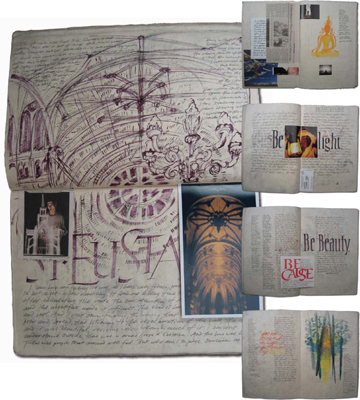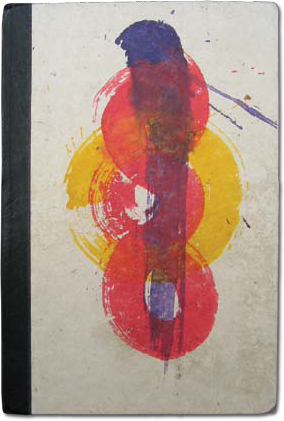- Color Your World
- Using Nature's Elements in Design
- Putting It into Practice
Putting It into Practice
You experience life through the physical perception of sense and the inherent sense-abilities of nature. It is important to be aware of what you sense so that you are able to identify your feelings and thoughts, and their relationships to the external world. Being aware of how you personally experience the world—as well as how all people respond to its universal qualities and properties—brings depth and balance to your design by appropriately integrating nature’s common sense-abilities. In the following exercises, you will experiment with color, sense, and element, and use your preferences to explore subtlety and sensuality in design.
CREATE A SENSE-ABILITY JOuRNAL
Keeping a workbook, sourcebook, or illustrated journal is a habit that traditionally helps designers to design. This is a useful strategy to develop your personal senses by visualizing and organizing your thoughts and responses to the world around you in visual, written, and letterform contexts. It will help you to identify your personal inspiration and to develop your creative processing and conceptual senses while organizing your thoughts, perceptions, and aesthetics as design.
- “I found I could say things with colors that I couldn’t say in any other way—things that I had no words for.”
- —Georgia O’Keeffe
The object of this exercise is to experience the sensuality of subtlety and to create relationships in different ways between element, color, and how you aesthetically represent them in your personal design work. To demonstrate this exercise, I’ve provided several spreads from master calligrapher and designer Tim girvin, owner of girvin in Seattle, Washington. These pages are from Tim’s journal Integrations (Figure 6.19) and reference his daily studies and experiences over a set period of time.

6.19 Various spreads from Integrations showing illustration, lettering, writing, collage, and design. Designer: Tim Girvin, Seattle.
Keep in mind that Tim has been integrating word, visual, and sense for decades. It is in the practice of journaling that you become good at it. I’ll provide some suggestions for you to start slowly and with support, so that you can integrate nature’s sense-ability and won’t feel as though you need to invent everything from scratch. If you want to jump in with your own creative process from the beginning, please do!
PART I: SENSE-ABILITY JOURNAL/DESIGNED SENSES
Use a bound book specifically and only for this particular journal. A good choice for your book would be a spiral bound sketchbook, a moleskin journal, or even a book you create and bind yourself with a specially designed cover, similar to the Integrations cover in Figure 6.20. A stiff or hard-covered journal that is easy to carry is important to use as a makeshift writing and drawing surface.

6.20 The cover of Integrations , a personal journal that integrates word, image, and object with feeling and sensual experience. Designer: Tim Girvin, Seattle.
Start your journal with this exercise or with other exercises in this chapter and continue it if you desire after you finish Design by Nature. Use it to note and explore your daily experiences. Part of subtlety is an appreciation for what you perceive as “mundane.” If you look closely, you’ll find the commonplace exists within your mind. Stretch it to see the extraordinary within the simple. Use your journal as a reference or use it as an event or timeline to observe your growth as an observant designer.
- Take a walk in nature with your notebook, colored pencils, paints, pen and/or pencils (use the medium you prefer but bring along supplies that you can integrate color with). It’s handy to use a backpack or other hands-free item for storage; this lets you easily collect found objects in nature and gives you a way to store them for later use.
- Choose a sense you would like to explore—sight, touch, taste, hearing, or smell—and intentionally focus on just this one particular sense for each walk. Your thoughts or external events will tend to make your mind wander. Continually bring your focus back to your chosen sense. For example, if you’ve selected sound, naturally you’ll be using sight, too. other senses will come into play. Continue to come back to the primary sense you are working with. Listen beyond louder noises: If you’re in a city park, listen to soft sounds close to you instead of the loud sounds that carry from a distance. Listen for the subtlety in natural sounds. Find alignments between sense and design. Silence is like white space. Reverse your normal tendency to hear (or sense) the overt. Find sound within silence. What does it sound like? Is it abstract or have a shape? Does it remind you of something from your childhood? Note what you become aware of.
- Take a moment to stop and sit. Reviewing your notes while still paying attention to the selected sense, write about what you experienced and how it made you feel. You can use singular words, a poem, a haiku, or a few sentences. Stay present with the sense so you can capture it as accurately as possible.
- Draw what you hear (or feel, see, taste, or smell). If you don’t know what it looks like, draw what you imagine it to be. This can be abstract and colorful. Integrate it with your writing. Tim girvin’s work in Integrations shows several different ways of doing this. Remember to give character to your lettering as well!
- You can develop this particular sense after you have fully explored it in notes and drawings. Integrate any found objects from nature, ideas, or visualizations that come up later—clippings, photos, or anything else relevant to you—and create a “designed sense” collage. Pay attention to the organization of your page. Design an initial cap or experiment with hand-drawn lettering styles. Be conscious of what is most relevant to you and how you can order, position, or prioritize with color, shading, boldness, and subtlety. Remember that cool colors recede and warm colors advance, and that small relationships work together to create the whole relationship.
- Experiment and find the best “sensual adjectives” to describe your sense. Try the same concept with several different approaches if you like. If you do this, review what doesn’t change. What can you change and what will you absolutely not? Why?
After exploring each of the primary physical senses, try to find the time to take a walk to explore other sensibilities that range beyond the five physical senses. You can explore memories (what inspired them?), people or events that spontaneously come to mind (synchronicity, perhaps?), or how nature fits something together that your focus moves to (observe pattern and shape). Don’t filter yourself; instead, concentrate on returning to the original intent each time you stray from it.
PART II: SENSE-ABILITY JOURNAL/SYNESTHESIA ENHANCEMENT
Synesthesia is a neurological state in which perceptual “bleeds” occur between the physical senses: A musical tone may have a flavor or color, or a number may have a particular sound. It doesn’t interfere with daily life or the ability to think; in fact, many synesthetes find the sensation of crossing senses quite enjoyable. Everyone has slightly different ways of perceiving the physical world, and as a designer you help others engage their senses through your creations. This exercise explores sensory boundaries to expand your creativity. The idea is to have multiple ways to express something that explores all or most of the senses.
- Can you imagine a number as a color? Does music have a flavor? Start this exercise by allowing yourself to sense in ways you haven’t before. The more completely you involve all your senses, the more compelling your design can be.
- Choose a line from a poem or song, or a sentence from a book you love, or write your own piece. You can also select words or thoughts from the prior exercise. Listen to music while working on this exercise and make your surroundings pleasing to you.
Using the text as inspiration, work with either Illustrator to create a vector illustration as in Figure 6.21 or draw images, shapes, and colors that illustrate your image. This can be anything that “makes sense” to you.

6.21 A vectorized graphic describing the complications of love by student Mauricio Martínez/Santa Fe University of Art and Design.
- When you’ve chosen what feels right to you, refer back to Tables 6.1 through 6.5 to see if there are elemental correspondences that are universal, or if your associations are unique to you.
- I see the months of the year like a giant Rolodex, spiraling through open space. They all have colors, genders, ages, and personalities.
- I also benefit from having a somewhat photographic memory with directions, phone numbers, addresses, and names, because I see them as a pattern of colors.
- It all tastes blue to me.
- —Teri Floyd, writer and synesthete
PART III: SENSE-ABILITY JOURNAL/GROW A SENSUAL GARDEN
In this part of the exercise, you will cultivate your sensual experiences as a visual narrative, as in Figure 6.22. Thanks to David grey, graphic Design Chair at Santa Fe University of Art and Design, for inspiring this exercise.

6.22 An illustration used for a calendar design based on earthly sensations and colors. Digital Artist: Cristian Boian, Romania.
- Choose one of the senses you have been working with. Take a few moments to reflect on this sense. What is it about its qualities that you respond to? List them.
- Choose colors and the appropriate element to describe your chosen sense. You can refer to the color wheels and the elements tables (Tables 6.1 through 6.5) to choose from, or you can spontaneously create what feels right for you.
- Integrate these pieces together into a poster or illustration, or as a series while it develops. You can also chart it as if it were a growing plant, from seed to bloom (refer to the Marian Bantjes illustration in Chapter 4 for an example). Remember that you are translating between a sense and the physical representation of it. grow your design through the inherent aspects of the connective pieces.